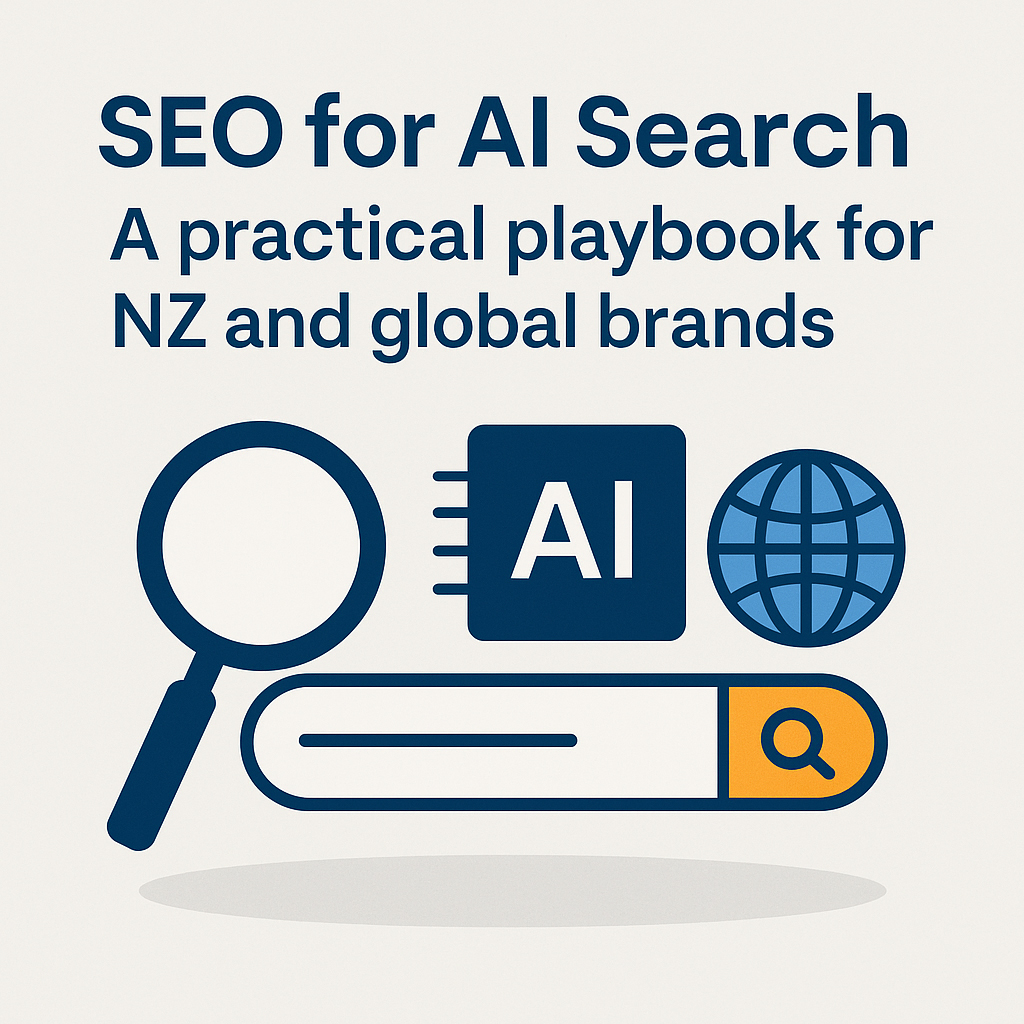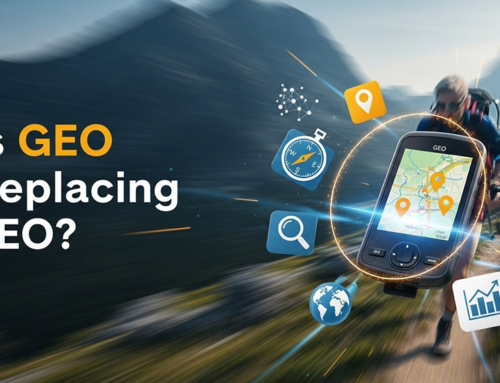
What is SEO for AI Search?
You want your pages named inside AI answers. That is the point.
Classic SEO earns blue links. This earns citations inside summaries and chat-style results.
Think of it as two layers working together. The base is solid site health and intent-aligned content. The next layer is answer readiness. Clear entities. Short, quotable blocks. Visible proof a model can trust.
Try this starter set.
- Define the topic in one sentence near the top
- Add a compact table or list with the key facts
- Use schema that mirrors the visible page
- Link to a source when you claim numbers
Will this replace your current SEO plan? No. It builds on it. That is why it sticks.
How it differs from classic SEO?
Classic SEO tries to win a ranked result. AI Search tries to win a named mention inside an answer. That shift changes how you write. You lead with a tight answer that a model can lift. You call things by their names, not vague phrases, and you describe relationships in plain words. Mark up people, places, products, and services so the page says what it shows. Add proof that can travel, like a short quote or a tiny table others might reuse.
The foundations still matter.
- Intent fit
- Crawlability
- Fast mobile pages
- Helpful content backed by real work
A simple test. If a model only quoted two lines, would a reader still get the point? If not, tighten and bring one clear table closer to the top.
A quick NZ note. We have watched simple checklist sections on local service pages trigger mentions inside answer boxes. Not every time. Often enough to keep doing it.
Why visibility shifts with AI Overviews and answer engines?
Your best content may not always win the blue link. It can still win a mention inside an AI answer. That is a shift worth leaning into.
AI Overviews blend sources and present a summary. Answer engines like Perplexity do the same, with visible citations. So your content needs to be easy to quote and easy to verify. Place clear definitions near the top. Present facts and steps in lists or small tables. Back claims with credible sources.
Keep writing for people. Also, write in a way that machines can parse fast. That mix changes your reach across engines.
How AI Overviews choose sources
No one outside Google has the full recipe, but patterns are clear enough to act on. Pages that state the answer simply, show evidence near the claim, and line up visible content with accurate schema tend to be chosen more often. Clean markup helps. A quick mobile experience helps. Being named by credible sites helps too.
Ask yourself. Would I cite this page in my own report? If the answer is a shaky maybe, add one proof line and one clarifying sentence. Then look again.
Small anecdote. We added a one-sentence definition and a two-row table to a buyer guide. A week later, that page started getting named inside an answer panel for a very specific query. Could be luck? But it did looked more like structure.
Readiness check and measurement basics
Before you scale changes, run a health check. Weak foundations hide wins. Look at access and index status, speed and mobile experience, data quality in GA4 and GSC, and a simple way to track assisted conversions and citations. Fix the top issues first. Upgrade content on the ten URLs that matter most. Measure weekly. Then expand.
Crawl access, index status, speed, UX
Engines and people both need easy access. Start by checking robots and sitemaps, then confirm that key pages sit in the index. Fix image weight and caching so pages load without effort. On mobile, make text readable without zooming and ensure buttons are easy to tap. Reduce layout shift above the fold so the first screen is calm. Small improvements here make your content easier to use and easier to quote.
If you want more depth, watch LCP, INP, and CLS. These field metrics often mirror the pain a real person feels. We have seen slow first input ruin a good article.
Clean data setup in GA4 and GSC
You want a view that ties effort to outcomes. In GA4, set up events for the actions that matter, such as form submissions, phone clicks, and long reads. Group them into goals so you can see movement without digging. In Search Console, track the pages tied to your answer blocks and watch the queries that drive them. Keep the reporting short. One page is often enough.
If you work across regions, separate profiles or collections help you tell NZ from the UK, Europe, Asia, the USA, Africa, and Australia. It sounds fussy. Saves you from bad calls later.
Build your entity layer
AI engines connect people, places, services, and topics. Help them do it right. Name your organisation the same way everywhere. List key people with short bios tied to pages. Describe services in plain words with one-line definitions. Add locations and service areas with real-world details. Link to your verified profiles with sameAs. This creates a map of who you are and what you do. Models use that map to select and cite your content.
We often do a one-hour entity sweep for clients in Auckland and London. It uncovers odd profile names, duplicate listings, and missing bios that hold pages back.
Organisation, people, services, products
Lay out the basics on site.
- Organisation page. History, team, contact
- People pages. Role, credentials, publications
- Service pages. What it is, who it helps, and steps
- Product pages. Specs, price, availability, FAQs
Keep each page tight with one clear purpose. Use internal links to connect related pages. That simple structure helps both humans and machines.
Content patterns that win citations
Engines like content that is easy to quote and verify. Readers do too. Design each page around a simple question. Answer it near the top. Then expand with steps, facts, and examples. Short definitions, numbered steps, compact tables, tiny proofs, and clear FAQs all help. Keep the language plain. Cut filler. Let the facts do the work.
One small thing. Put the most helpful sentence first, even if it feels blunt. That is often the bit an AI surface lifts.
Answer blocks, definitions, and checklists
Place an answer block within the first screen of the page. One to three sentences. Simple words. Avoid jargon where you can. Follow with a checklist.
- What to know
- What to do next
- What to avoid
This pattern works for most topics. It helps readers act fast and helps models lift text without confusion. Add a short note at the end that points to deeper context.
Comparisons, tables, and short proofs
Comparisons help people decide, which is why models like them too. Use a compact table with columns for option, key feature, and best for. Finish with a short recommendation that explains your call in one sentence. Add a proof line where it matters. That could be a number from your data, a published spec, or a quote from a credible source. Keep it tight. Two lines can do the job.
We have seen small tables copied into forums and newsletters. That is free distribution. It also teaches engines that you publish useful facts.
Sector playbook quick-start table
| Sector | Answer pattern to use | Proof to add | Schema priority | Call to action |
|---|---|---|---|---|
| Trades and home services | Problem then fix in steps | Review line naming a suburb | Local Business, Service, FAQ Page | Call now or book a visit |
| Legal and conveyancing | Clause explainer with definition and steps | Case reference or lawyer quote | Article, FAQ Page, Organisation | Speak to a conveyancer |
| Healthcare | Symptom then action with risk note | Source citation or clinician byline | Article, Person, Local Business | Call the clinic |
| Retail and e-commerce | Comparison table then pick | Spec sheet or customer review | Product, Aggregate Rating, FAQ Page | Buy now or check stock |
| SaaS and tech | How it works in three steps | Screenshot or performance metric | Software Application, How To, Video Object | Start a trial |
| Property and real estate | Checklist with timelines | Council link or price range | Local Business, Service, FAQ Page | Request an appraisal |
| Government and nonprofit | What, who qualifies, and how to apply | Policy link or impact metric | Organisation, FAQ Page, Web Page | Contact the team |
| Professional services | Definition, scope, inclusions | Case study line or testimonial | Service, Organisation, Review | Book a consultation |
Schema and data kit
Schema does not rank content on its own. It explains it. Your goal is simple. Make your markup match what users can see. Keep it valid. Keep it current.
Focus your effort on a small kit. Organisation and Local Business for who you are. Service or Product for what you offer. Article and FAQ Page for your content. Video Object if you publish clips. Website and Breadcrumb List for structure. Use preview controls with care.
Organisation, Local Business, Service
- Organisation sets who publishes and owns the site
- Local Business ties your brand to places and services
- Service names the thing you do and who it is for
Align the fields to visible text. Avoid padding. Add sameAs links to verified profiles.
Local and global playbook
Signals differ by market. The core remains the same. Prove who you are, what you do, and where you work. Then speak the language of the buyer in that region. Small tweaks matter more than people think.
New Zealand signals and proof
Show local proof. Real addresses, suburbs served, and phone numbers that work. List memberships that matter here. Use NZ English and common terms. Bring in reviews that name cities and towns. Add service detail pages for the main centres.
Australia
State-level pages help. Mention licensing where it applies. Use Australian English and terms people expect. Add pricing ranges if the market expects them. Include local reviews and partner links.
United Kingdom and Europe
Spell out privacy and cookie choices clearly. Use UK spellings and sector terms. In Europe, note certifications buyers scan for. Add country-specific service pages if you operate across borders. Mention delivery times and VAT where relevant. If you process data, match consent to GDPR and UK ICO guidance.
United States
Address scale and the expectation for proof. Add detailed FAQs, specs, and comparisons. Cite sources when you make claims. Include testimonials with names and roles. If you cover multiple states, call them out. If you collect data, keep the CPRA in mind.
FAQs
What is SEO for AI Search?
It is the work that helps your pages get named inside AI summaries and answer engines. It builds on classic SEO and adds answer readiness.
Do I need GEO if I already do SEO?
Yes, if you want citations in AI results. GEO guides how you structure answers, entities, and proof so models can trust you.
How do I know if I appear in AI Overviews?
Keep a simple log of sightings and use screenshots. Track the query, the page cited, and the position. Check weekly.
Which schema types help most?
Start with Organisation, LocalBusiness, Service or Product, Article, and FAQPage. Add VideoObject if you publish clips.
How long until I see results?
You can earn mentions within weeks on some topics. Bigger gains need steady work. Watch assisted conversions as well as clicks.
What should a monthly plan include?
A short health check, answer-block updates on priority pages, schema validation, a citation-log review, and one small playbook move per sector you serve.
Any legal or data risks?
Nothing here is legal advice. If you collect personal data, follow local rules. For example, GDPR in the EU and UK, the CPRA in California, OAIC guidance in Australia, PDPA in parts of Asia, and POPIA in South Africa.
Work with Net Branding
Need a partner who does this daily? We can help with GEO and AI-focused search.
Be seen, be heard, be found.
- Content that earns mentions across AI surfaces
- Entity sweeps and schema validation
- NZ and global sector playbooks
- Clean measurement and assisted-conversion reporting
Connect with Net Branding
Net Branding Limited
165 Orakei Road
Remuera
Auckland 1050
Phone 09 523 0478
Mobile 021 122 9116
sales@netbranding.co.nz
Author bio
Cathy Mellett is the founder of Net Branding, an Auckland-based digital agency started in 2008. She helps teams earn real visibility in Google, AI Overviews, Bing Copilot, and Perplexity. Plain talk first. Results next.
She has worked with New Zealand brands and with clients in the UK, Europe, Asia, the USA, and Africa. Cathy cares about clear content, tidy data, and simple measurement. I think that is why her advice lands well with busy owners.
When she is not mapping entities or fixing messy tracking, Cathy writes about digital wellbeing and the human side of tech. If you want support with GEO and SEO for AI Search, you can reach her team at Net Branding. Be seen, be heard, be found.








